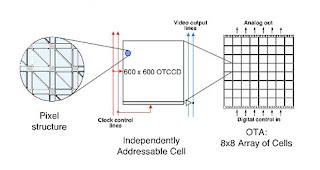The orthogonal transfer array (OTA) is a novel charge coupled device (CCD) imager based on the orthogonal transfer CCD (OTCCD). The OTCCD, in turn, is a device capable of charge transfer in all directions and has been developed for adaptive imaging in ground based astronomy. By using a bright guide star as a beacon, the OTCCD can correct for
wavefront tilt due to atmospheric effects as well as
compensation for telescope shake,
which in turn enhances the resolution and SNR . However, for wide field of view imaging the atmospheric wavefront distortions decorrelate over distances more than a few 10’s of arcmin and hence an array of independently driven OTCCDs is required. To resolve this issue we developed the OTA, which consists of a two dimensional array of OTCCDs combined with addressing and control logic to enable independent clocking of each OTCCD. This device enables spatially varying electronic tip tilt correction and was developed for the Panoramic Survey Telescope and Rapid Response System (Pan STARRS) program at the University of Hawaii Institute for Astronomy (UH/IfA) .
The basic architecture is an 8 × 8 array of OTCCDs on a 50 × 50 - mm die.
This is the individual OTCCD, or cell, comprising a 590 × 598 - pixel imaging array of 10 -μm pixels, serial register and readout circuit.
After:
Lincoln Lab
wavefront tilt due to atmospheric effects as well as
compensation for telescope shake,
which in turn enhances the resolution and SNR . However, for wide field of view imaging the atmospheric wavefront distortions decorrelate over distances more than a few 10’s of arcmin and hence an array of independently driven OTCCDs is required. To resolve this issue we developed the OTA, which consists of a two dimensional array of OTCCDs combined with addressing and control logic to enable independent clocking of each OTCCD. This device enables spatially varying electronic tip tilt correction and was developed for the Panoramic Survey Telescope and Rapid Response System (Pan STARRS) program at the University of Hawaii Institute for Astronomy (UH/IfA) .
The basic architecture is an 8 × 8 array of OTCCDs on a 50 × 50 - mm die.
This is the individual OTCCD, or cell, comprising a 590 × 598 - pixel imaging array of 10 -μm pixels, serial register and readout circuit.
After:
Lincoln Lab











留言
張貼留言